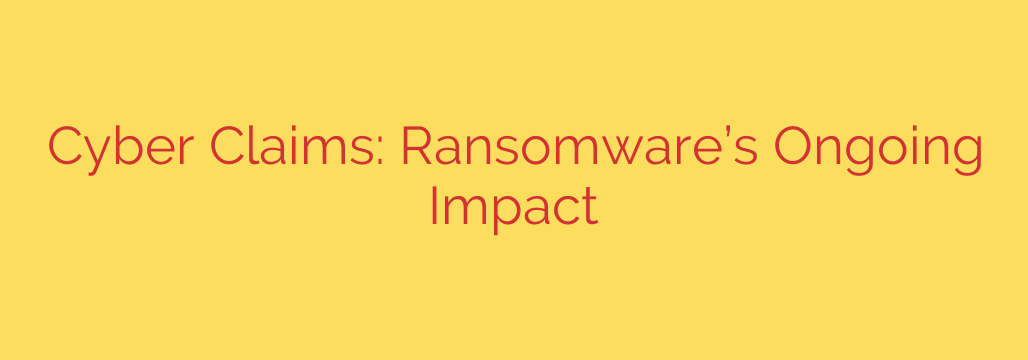
Ransomware’s Lingering Shadow: Understanding Its True Impact on Your Business and Cyber Insurance
Even as headlines shift to new threats, ransomware remains a persistent and devastating force in the digital landscape. Far from being a solved problem, ransomware attacks are evolving, becoming more sophisticated and inflicting deeper, more lasting damage on businesses of all sizes. Understanding the true scope of this threat is the first step toward building a resilient defense and navigating the complex world of cyber insurance claims.
The modern ransomware attack is rarely a simple case of locked files. Threat actors have shifted their tactics to maximize leverage and inflict the most pressure possible on their victims. This has led to the rise of multi-faceted extortion methods that go far beyond basic encryption.
At the forefront of this evolution is double extortion, where criminals not only encrypt your critical data but also steal a copy of it first. If the ransom for the decryption key isn’t paid, they threaten to leak the sensitive information publicly. This could include customer data, employee records, or proprietary intellectual property, creating a second, simultaneous crisis centered on data privacy and reputational damage.
Calculating the Real Cost: Beyond the Ransom Demand
One of the most critical misunderstandings about ransomware is that the demanded payment is the primary financial loss. In reality, the ransom itself is often just the tip of the iceberg. The true costs associated with a ransomware incident are far-reaching and can cripple an organization long after the initial attack is contained.
The most significant financial impacts frequently include:
- Business Interruption: This is often the largest component of a ransomware claim. Every hour your systems are down translates to lost revenue, decreased productivity, and stalled operations. For manufacturing, logistics, or retail companies, this downtime can be catastrophic.
- Incident Response Costs: Containing the breach, eradicating the malware, and safely restoring systems requires specialized expertise. This involves hiring forensic investigators, legal counsel, and public relations firms to manage the crisis, all of which come with substantial costs.
- Data Recovery and System Rebuilding: Even with backups, the process of restoring data and rebuilding servers and workstations is time-consuming and expensive. In many cases, hardware must be replaced entirely to ensure no remnants of the malware remain.
- Reputational Damage: The loss of customer trust can have a long-term financial impact that is difficult to quantify. A public data breach can drive away existing clients and deter potential new ones, leading to sustained revenue loss.
- Regulatory Fines: If sensitive customer or employee data is compromised, your business could face significant fines under regulations like GDPR, CCPA, or HIPAA for failing to protect that information.
How Ransomware is Reshaping the Cyber Insurance Market
The relentless frequency and high cost of ransomware claims have forced the cyber insurance industry to adapt. Insurers are no longer simply covering losses; they are actively pushing for better security postures from their policyholders. This has created a “hard market” characterized by rising premiums and stricter underwriting requirements.
To even qualify for coverage today, most insurers demand that businesses have specific, non-negotiable security controls in place. Lacking these fundamental protections can lead to denied coverage or prohibitively expensive premiums.
Proactive Defense: Key Strategies to Mitigate Ransomware Risk
While no defense is impenetrable, a layered security strategy can dramatically reduce your risk of a successful attack and strengthen your position with insurance carriers. Focusing on prevention and preparedness is the most effective investment you can make.
Here are the essential security measures every business must implement:
Enforce Multi-Factor Authentication (MFA): This is the single most effective control for preventing unauthorized access. Insurers now consider MFA a mandatory prerequisite for coverage, especially for remote access and privileged accounts.
Maintain Immutable and Offline Backups: Your ability to recover without paying a ransom depends entirely on your backups. Follow the 3-2-1 rule (three copies of data, on two different media types, with one copy off-site). Ensure at least one copy is “immutable” (cannot be altered or deleted) or stored offline, completely disconnected from the network.
Conduct Regular Employee Training: Humans are often the first line of defense. Ongoing security awareness training that teaches employees to recognize and report phishing emails and other social engineering tactics is crucial for preventing initial entry.
Develop and Test an Incident Response Plan (IRP): When an attack happens, you must be prepared to act quickly and decisively. A well-documented IRP outlines who to call, what steps to take, and how to communicate. This plan should be tested regularly through tabletop exercises to ensure its effectiveness.
Utilize Advanced Security Tools: Invest in modern endpoint protection like Endpoint Detection and Response (EDR) or Extended Detection and Response (XDR). These tools go beyond traditional antivirus by monitoring for suspicious behavior and enabling a much faster response to potential intrusions.
Ultimately, ransomware is more than an IT problem—it’s a critical business risk that demands executive attention. By understanding its true impact and implementing a robust, proactive security strategy, you can protect your organization’s finances, reputation, and future.
Source: https://www.helpnetsecurity.com/2025/10/01/insurance-claims-ransomware-h1-2025/








